Ready to set up an SEM campaign? Use this guide to hit the ground running.
Here, you’ll find:
- What defines an SEM campaign
- How to set up an SEM campaign with the proper foundation
- Pro tips for effectively running your Google Ads account
- Further reading for optimization and auditing
Search for the term search engine marketing, or SEM, and you’ll likely come across a few varying definitions.
Sometimes SEM is used to refer to paid search or pay-per-click (PPC) advertising only. Other times, it serves as an umbrella term for any form of digital marketing that increases website visibility (i.e. PPC and search engine optimization, or SEO).
Needless to say, if you type “how to set up an SEM campaign” into your preferred search engine, you’ll probably end up with a mixed bag of results.
So here’s the deal:
After many years in the industry, we consider SEM a term that can encompass both SEO and PPC. But today, we’re going to focus on the basics of setting up a paid ad campaign on a search engine’s advertising program — and tips along the way for a beginner.

Not every business is ready to launch an SEM campaign. In fact, many aren’t.
Before you set up an SEM campaign: Is PPC right for your business?
Both PPC and SEO are powerful tools for any marketing strategy, but paid search ads are especially enticing because of their reputation for being effective fast.
Once your PPC ads are live and optimized, you can see new visitors flow to your website that same week. And, unlike other marketing platforms, paid ads give you a ton of data along the way. This gives you more control to narrow in on your target audience.
So, what’s the catch? Well, there are a couple. (Cue sad trombone.)
First, not every business is ready to launch an SEM campaign. In fact, many aren’t. In order to yield successful results you need:
1. Budget (time)
Paid ads can bring about results fast, sure. But that’s relative to other marketing methods out there. While traffic can start flowing to your site right away, that doesn’t mean it’s converting traffic (yet).
It takes weeks of collecting data and making optimizations to see the real magic happen — but that also requires an investment up front in both time and in money.
2. Budget (finances)
As we just mentioned, PPC takes an up front investment as your campaign settles in. And beyond this investment period, businesses should be prepared to dedicate enough monthly spend into their budget to see results.
If your ad spend isn’t competitive, PPC won’t work.
3. Prepared to scale
Believe it or not, PPC can be so effective (bringing in a ton of leads and customers) that unprepared businesses can’t keep up.
To combat this, make sure your business model is scalable. Is your team prepared? Is your inventory? What about your team’s availability to answer the phone? Be prepared for whatever your business needs to scale in a hypothetical mega-success story.
4. A high-quality website
Your website needs to be fast, informative, and easy to navigate across devices. This is where an SEO strategy and PPC overlap so powerfully.
Google prioritizes high-quality content from high-quality websites for organic search results and PPC ad placements. A beautifully structured ad campaign is useless without a properly built website.
5. Business goals on lock
What do you need to be profitable? How many leads? What are your close rates? I know, you probably have these little details memorized by now, but these numbers will dictate your SEM strategy and goals.
Write ‘em down and keep them handy for your SEM campaign buildout.

Is your business model scalable?
…One last catch?
PPC takes a lot of work week-to-week. Ad creation and variations, conversion tracking, optimizing your landing pages, and setting negative keywords so you aren’t paying for low-value visitors.
Observing which ad groups, keyword groups, and landing pages are the top performers and which tests you should pause to free up extra juice for your successful campaigns. An SEM campaign is a great way to convert money into more money — if you have the time to learn and implement it properly.
Ready for the challenge? Read on for more insights into setting up your own SEM campaign.
Pick a PPC network
So, you’re all and ready to set up an SEM campaign.
First up? Review your search engine advertising network options. There are a handful out there, such as:
- Google Ads (FKA Google AdWords): Displayed across the Google network, including Google search, the Google Display Network, and YouTube
- Microsoft Ads (Bing Ads): Displayed on Bing‘s search engine, display ads, ads on DuckDuckGo, and LinkedIn
- Yahoo Gemini Ads: Displayed on Yahoo, AOL, and TechCrunch
The way we see it, you have two options:
- Google — this is the go-to search engine for 90% of the world and has some of the best targeting and testing options available.
- If your audience hangs out in a different virtual venue, start there first.
While some search engines like Bing can give you access to a smaller, segmented group with higher income and less competition, Google Ads is the largest advertising platform in the world with some of the best targeting and testing options available.
Since this is a beginner’s guide, we’ll keep things broad enough to apply to any ad network. Though we admittedly have a strong preference for Google Ads, the same core concepts will still apply to other ad platforms.
Start with keywords (before it’s too late!)
Before Google’s newest campaign type, Performance Max (which uses automated ads that targets users based on their interests, i.e. audience signals), Google Ads’ accounts relied almost entirely on keywords.
And advertisers use keywords to build our strategies, organize ad groups, and target users by the search terms they use to find our services or products (more on this later).
Now, not to be dramatic, but the future of Google is leaning more toward an automated, “smart” future. “Yikes!” exclaim advertisers everywhere.
See, more automation = less control.
But, for now, keywords are still the key to our autonomy. And keywords will always be wildly important to understand our audiences; after all, we need keywords to craft content that is relevant to a user’s needs.
Alright, onward to the real deal.
Quick-and-dirty keyword research rundown
There are plenty of ways to conduct keyword research, starting with good ol’ Google search.
First, put yourself in your target market’s shoes: What terms would they use to find you? Then, get to typing. Experiment with Google’s predictive search (the way Google autofills your search terms based on popularity or similarity).
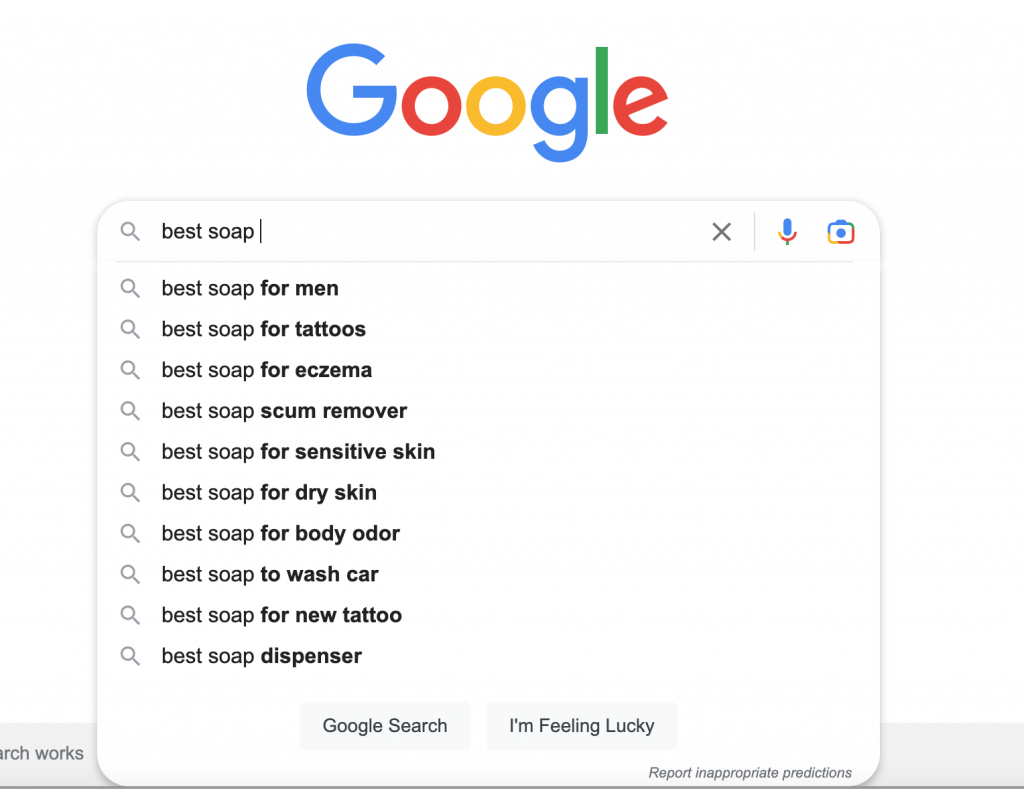
And check out the “People also ask” section of the search engine results page (SERP) to narrow in on keyword variations and related terms:

From there, check up on competitor brands. See which ads they’re running and which products they focus on the most so you can learn from their decisions.
Pro tip: AnswerThePublic is a helpful tool to find commonly-searched-for questions your target market is asking online so you can optimize keywords with search intent in mind.
When you’ve exhausted your Google search, you can level up your keyword research game with keyword research tools like Ahrefs, Google Trends, or Semrush. These SaaS tools are similar to a search engine in that you enter specific keywords, and the tool comes back with related keywords based search engine performance data like monthly search volume and ranking difficulty.
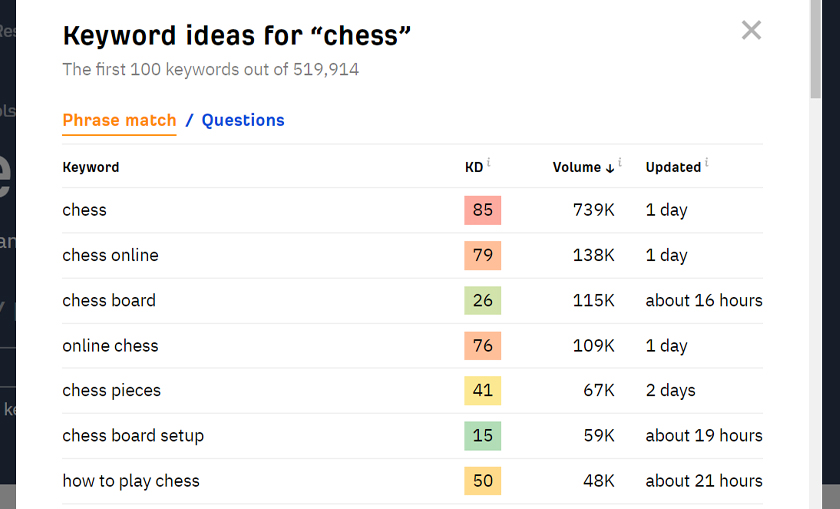
Here’s a guide we wrote on competitive keyword research to get you started: Keyword Research 101.
Landing pages
When a user clicks your ads, where will they end up?
The page they arrive at is called the landing page. When you set up an SEM campaign designed to convert, you need to create optimized, focused landing pages that match the ads you want to run as well.
Google (and other ad networks) judge the quality of your ads based on how fluid the transition is from your ads to your landing pages. So any disconnect or lacking continuity will cause problems for users, making your ads less practical and ineffective.
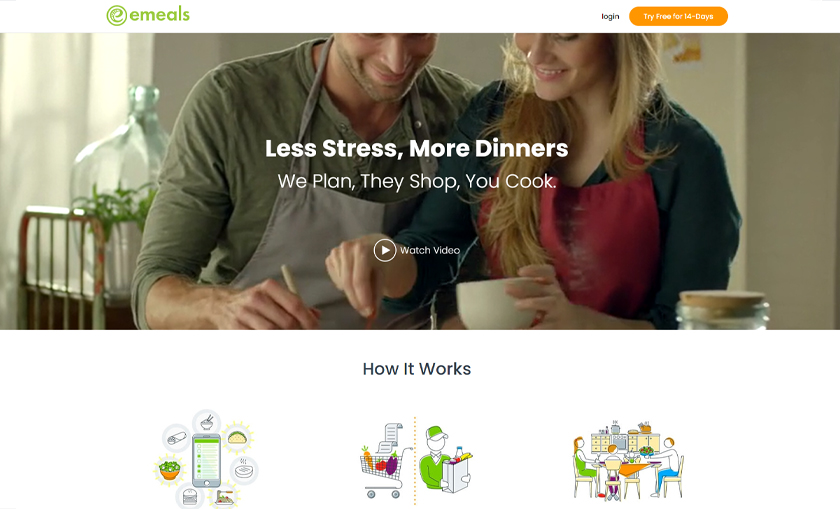
Create optimized, focused landing pages that match the ads you want to run.
These disconnects can be as significant as a single-product ad taking a user to a generic ecommerce storefront or as minor as your ad mentioning a 10% discount and your landing page mentioning a 15% discount.
It would be best if you focused on making your landing pages deliver a solution to your user as clearly as possible. That might mean convincing them to buy a product, sign up for a subscription, or otherwise convert them into a lead or paying customer.
A lot goes into successful landing pages, so check out our Ultimate Guide to Landing Pages here.
Understanding campaign structure
When it comes time to create your PPC campaigns, it’ll help to understand the way these accounts are structured.
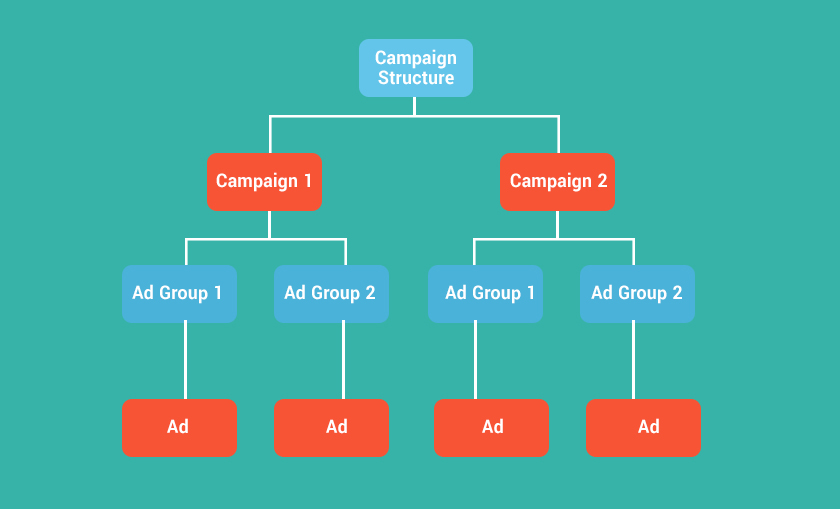
Campaign structure.
To set up an SEM campaign, you’ll often follow roughly the same three-tiered housing system inside your account, no matter the platform:
- Campaigns. Your advertising “categories” will be divided into specific campaigns, like branded searches, summer sales, or returning customers.
- Ad groups. Within each campaign, ad groups act as subcategories, or segments, within that primary category. Ad groups are typically organized around specific keywords, offers, or products.
- Ads. Within each ad group, you’ll have the ads themselves. You’ll need multiple versions to test against one another within the same ad group, so they share the same targeting and budget settings.
If your ads are extensive, your budget is robust, and your product library is sufficiently disparate, you might have one more level at the top. You may have a Master Account and sub-accounts for different departments or types of products. For example, Nike might have an Athletic Wear segment, a “Shoes” segment, and so on.
It depends on how you want it organized and connected within your company.
Crafting compelling ad copy
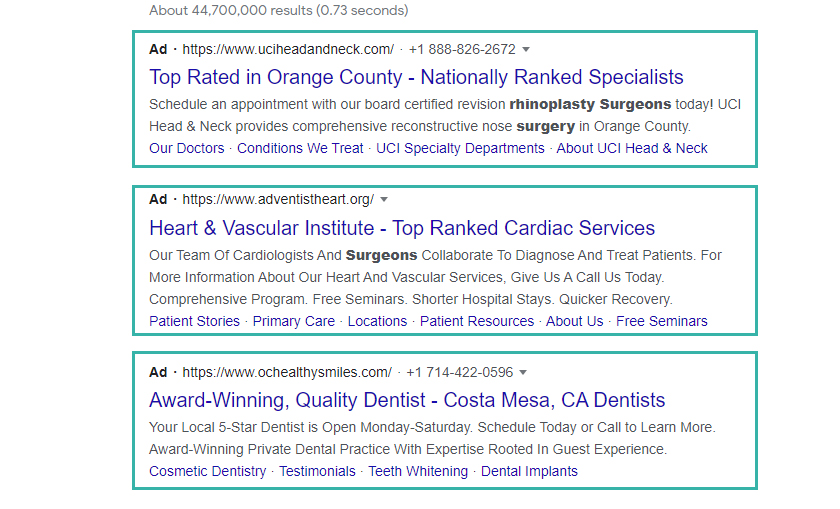
Ad copy.
Ad copy is where a large portion of your efforts in day-to-day SEM management will be. Compelling ad copy is what makes advertisers stand out in the search engine results pages (or on the landing page itself) and entices people to click.
But, there are rules.
Ad copy needs to be accurate (no-bait-and-switch offers), free from spammy use of symbols and typos, and present a clear offer. The quality and relevance of your copy significantly impacts your ads’ performance and click-through-rate (CTR), which is why testing ad variations is essential.
Your copy doesn’t need to be perfect the first time, but you need to be in the right ballpark. That means knowing who you’re reaching and what your potential customers are interested in, so you know what points to mention for your most promising ads.
Conversion tracking and analytics
Without proper conversions tracking, your advertising platform has no way to learn what’s working and what’s not.
Conversion tracking setup.
In other words, your PPC advertising is only as good as the data you use to make decisions. Here’s a look at several different kinds of tracking you can set up, along with custom tracking for specific ad networks:
- UTM tracking. UTM parameters are tacked onto the end of URLs like lampreys, tracking information about the specific iteration of a clicked link. They are essential for monitoring things like multiple ads that all point to the same page (so you can see which ads get the clicks and which users from which sources do the converting) or even multiple links from the same source to the same destination.
- Automatic Conversion tracking. Google Analytics does a lot of automatic tracking based on standardized formats and information, so they can track conversions from users who arrive on ads without any extra setup on your part.
- Manual Conversion tracking. By setting up advanced conversion tracking in your Google Analytics, you can track events that aren’t standardized and assign specific values to them. You can also track phone calls or live chat metrics using the right tools.
The more information you have on hand, the better you can inform your decisions in optimizing your ads, refining your keyword lists, adjusting your landing pages, and more. Without conversion tracking, you’re running blind and have no idea which of your ads are responsible for your conversions.
Split tests with ad variations
Split testing, also known as A/B testing, is a way to compare two or more variations on a single ad to see which one performs better. This goes beyond ad copy.
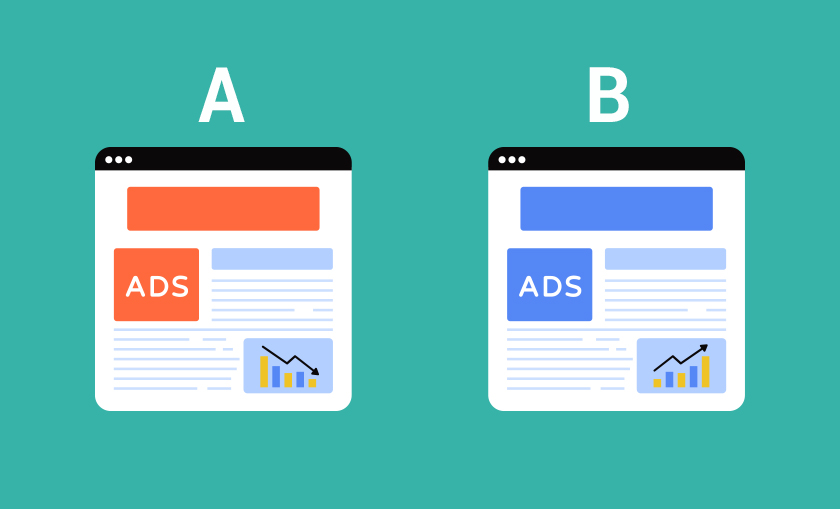
Give your ad variations enough time to collect enough data.
You can use this testing to change and optimize everything from your specific keywords to your landing page, your ad extensions, bidding strategy, display URL, and more.
Small changes can add up in a big way. The trick is to be structured with your changes; test only a single variable at a time, and make sure your budget, website traffic, and search volume are all sufficient enough to give you statistically significant samples.
You also want to give your ad variations enough time to collect enough data; running those ads for a few days won’t give you the data you need to make an informed decision.
For more information, here’s a guide on setting up effective A/B testing and a list of real-life examples of excellent tests.
Review, audit, and iterate on your PPC campaigns
Between your analytics and your tests, you should have plenty of information to make optimization decisions. You can see the quality score of your landing pages, your ad rank, the conversion rate of your search ads, the clicks on your call-to-action, your cost per click, your CPA (cost per action), and more.
Armed with that information, you can audit and improve your search engine marketing campaigns from top to bottom.
Remember when we said that creating your ad copy would be the bulk of your work? This is why. You’re always going to be testing, iterating, and optimizing your ads.
You can never rest on your laurels and view your ads as “good enough.”
Pro tip: ConversionIQ, HawkSEM’s proprietary marketing platform, tracks data from all of your marketing campaigns on one easy-to-navigate dashboard. This gives you insight into your complete buyer’s journey — from first click to purchase, to where some users fall off — and empowers you to make effective optimizations that directly impact your return on investment (ROI). Check it out here.
The takeaway
This is just a sampling of what goes into the process when you set up an SEM campaign.
Truthfully, it takes a whole lot of time and resources to see big returns on PPC campaigns on your own. That’s why most agree that paid search should be left to the experts.
Whether you opt for SEM services from an in-house marketing help, a contracted consultant, or an SEM agency, knowing the basics will help you find a qualified team player.
But if you’re looking for an SEM agency in the top 3% of the country, look no further.